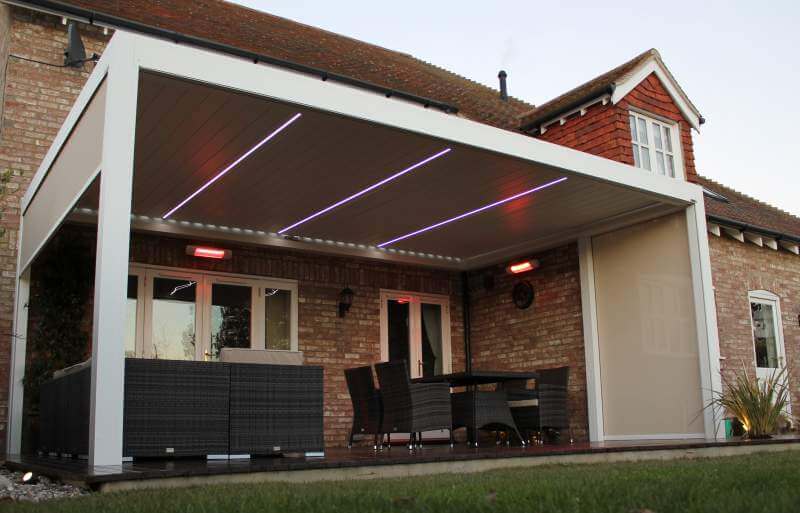What is infrared heating?
Infrared heating is a popular form of heating that uses electromagnetic radiation to transfer heat. Unlike other heating methods that mainly rely on convection, infrared heating works by emitting infrared radiation that penetrates objects, including people and furniture. This form of heating is widely used in various applications, including outdoor patios, homes, and commercial spaces.
Infrared radiation is invisible to the human eye and lies on the electromagnetic spectrum between visible light and microwaves, with a longer wavelength than visible light. When an infrared heater is turned on, it emits infrared radiation that is absorbed by the objects in its path. As the objects absorb this radiation, they begin to warm up, and the surrounding air also gradually heats up.
The beauty of infrared heating is that it provides quick and efficient warmth without wasting energy. Unlike other heating methods that heat up the air and then the surrounding objects, infrared heating directly heats up the objects, which means that it consumes less energy and heats up the space quickly. This makes it an ideal solution for outdoor spaces, where traditional heating methods, such as gas heaters, may not be feasible.
Infrared heaters come in various forms and types, including freestanding heaters, wall-mounted heaters, and tabletop heaters. They can be powered by different energy sources, including electricity, propane, natural gas, and other fossil fuels. Some infrared heaters are equipped with advanced features such as remote controls, 24-hour timers, and safety instructions to ensure that they are used safely.
In conclusion, infrared heating offers a versatile and efficient heating option that allows you to enjoy warmth and comfort in various spaces. Whether you need to heat up your outdoor patio, living room, or commercial space, infrared heaters can provide an energy-efficient and effective solution that makes you feel warm and comfortable.
Benefits of infrared heaters for patios
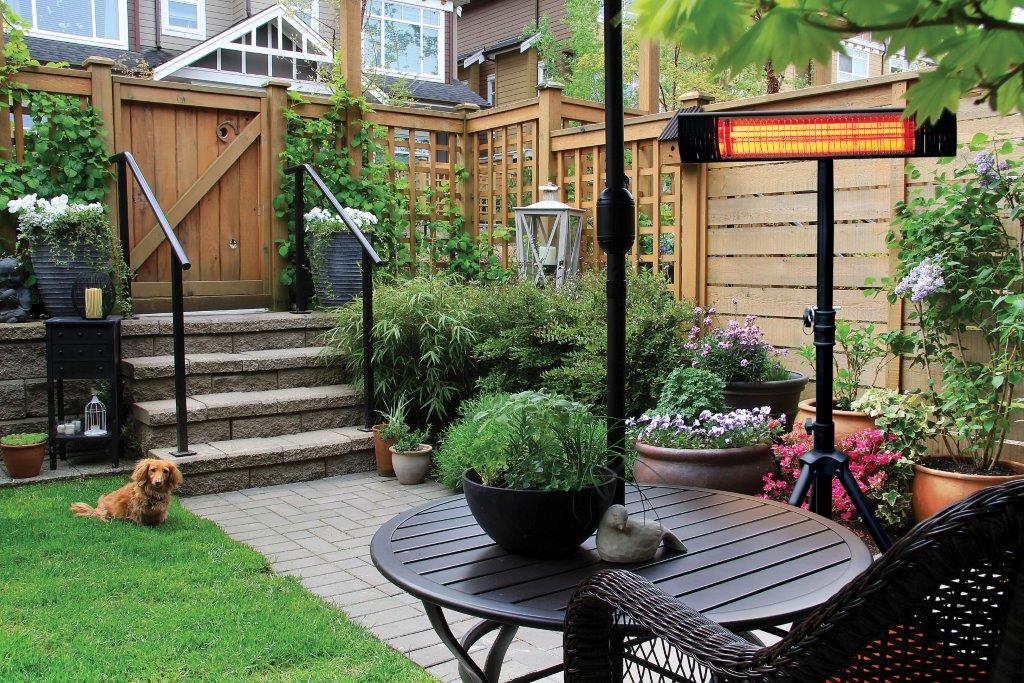
If you’re looking for a way to keep your patio warm and inviting during cooler months, infrared heaters might be just the solution you need. These innovative heating devices offer a range of benefits that make them ideal for outdoor environments, from their energy-efficient operation to their high level of safety.
One of the key advantages of infrared heaters is their ability to deliver instant, focused heat. Unlike traditional heaters that take several minutes to warm up, infrared heaters emit a powerful stream of radiant heat as soon as they are switched on. This enables them to quickly and efficiently heat up both small and large outdoor spaces, providing a comfortably warm atmosphere that can be enjoyed by all.
Another benefit of infrared heaters is their energy efficiency. Traditional outdoor heating methods, such as gas heaters, can be energy-intensive and expensive to operate. In contrast, infrared heaters use far less energy to provide similar levels of warmth, making them both cost-effective and environmentally friendly. Additionally, these heaters don’t release any harmful emissions into the air, creating a safer and healthier outdoor environment.
Infrared heaters are also highly versatile, and can be used in a variety of different settings and situations. They come in a range of sleek designs, sizes, and power levels, so you can choose the perfect model to match your specific needs and space. Some infrared heaters are designed for freestanding use, while others are meant to be wall-mounted, making them a great option for smaller patios where floor space is at a premium.
Finally, it’s worth noting that infrared heaters are also extremely safe to use. They don’t have any exposed surfaces that can cause burns, making them ideal for families with young children or pets. Many models also come with additional safety features, such as automatic shut-off mechanisms and tip-over protection, further reducing the risk of accidents.
In summary, infrared heaters are a powerful and efficient way to heat up your patio during cooler months. Whether you’re looking to create a cozy ambiance for outdoor parties or simply want to enjoy your patio space on cold nights, these versatile heating devices offer a range of benefits that make them a worthwhile investment for any outdoor enthusiast.
Types of Infrared Heaters
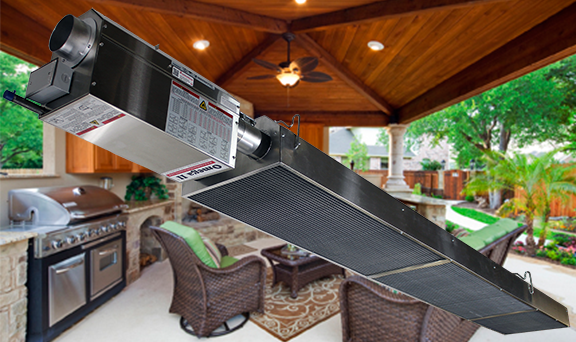
Infrared heaters have become an increasingly popular choice for providing supplemental warmth in homes and outdoor spaces. These heaters are designed to emit infrared radiation, which heats objects and surfaces within their immediate vicinity. If you’re considering purchasing an infrared heater, it’s essential to know that these heaters come in different types. Here are some of the different types of infrared heaters available on the market:
1. Quartz Infrared Heaters: A quartz infrared heater uses heating elements made from quartz tubes. These tubes are filled with a tungsten filament and a small amount of halogen gas. When you turn on the heater, an electric current passes through the filament, creating a bright glow and generating heat that emanates out in all directions. Quartz infrared heaters work exceptionally well when heating up small to medium-sized spaces.
2. Ceramic Infrared Heaters: Ceramic infrared heaters utilize ceramic plates as their heating element. The plates are lined with a coating that emits infrared radiation when heated, providing even heat distribution throughout the area. The most significant advantage of ceramic infrared heaters is that they are energy efficient and produce a consistent level of heat.
3. Carbon Infrared Heaters: Carbon infrared heaters are popular because they are more energy-efficient than other types of infrared heaters. These heaters use carbon fiber panels as their heating element and generate heat when an electrical current passes through them. Carbon infrared heaters deliver instant warmth and are an excellent choice for large outdoor spaces.
4. Panel Infrared Heaters: Panel infrared heaters are unique in that they are usually made of tempered glass and are mounted onto a wall or ceiling. They provide heat by emitting infrared radiation that is absorbed by surrounding objects, effectively heating up the space below them. Panel infrared heaters are a great option for those who want a sleek and modern design.
In conclusion, infrared heaters are a great way to add extra warmth to your home or outdoor space. When choosing an infrared heater, it’s essential to consider the different types and understand their unique characteristics to determine which one is the best fit for your needs. Whether you opt for a quartz, ceramic, carbon, or panel infrared heater, any of these types will provide you with an efficient and effective supplemental heating solution.
Remote Control Heaters
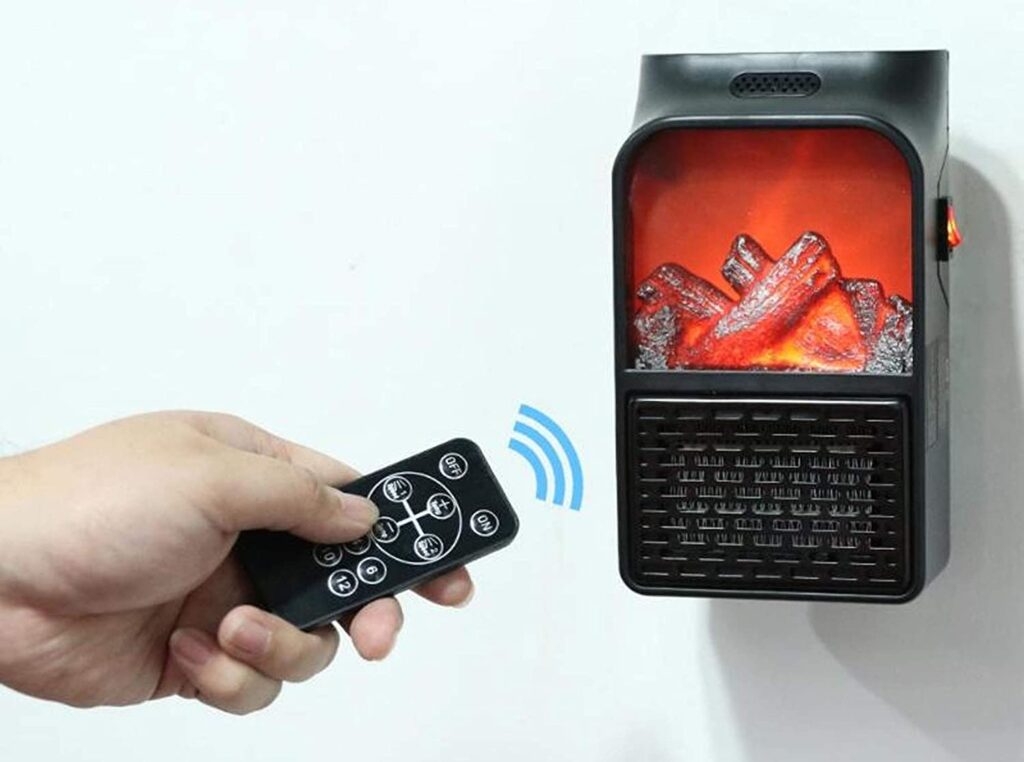
If you want to enjoy the warmth and comfort of a heater without the hassle of getting up to adjust it, a remote control heater might be just what you need. Remote-controlled heaters offer convenience and ease of use, making them popular among homeowners and office workers alike.
With a remote control heater, you can easily adjust the heat output and temperature settings without having to leave your seat. This is especially useful for individuals who experience mobility issues or have trouble reaching the heater’s control panel.
One of the main benefits of remote control heaters is that they allow you to customize your heating experience. You can set the temperature to the exact degree that you prefer and adjust the heat output to suit your needs. Additionally, many remote control heaters have timer functions that allow you to set them to turn on or off at specific times, helping you save energy and money on your electricity bill.
Remote control heaters come in a variety of styles and sizes, so you can choose the one that best fits your needs. For small spaces or personal use, portable remote control heaters are perfect. They’re easy to move around and can be placed wherever you need them. For larger spaces, wall-mounted remote control heaters are ideal as they provide heat to a larger area, and are out of the way. There are also remote control heaters that are specifically designed for outdoor use, making them great for patios or decks.
When purchasing a remote control heater, it’s important to consider safety features. The heater should have overheat protection, which automatically shuts off the heater if it reaches dangerous temperatures. Tip-over switches are also an essential safety feature, ensuring that the heater shuts off if it accidentally falls over.
Overall, remote control heaters are an excellent choice for anyone who wants an easy-to-use, customizable heating solution. With features like temperature control, timer settings, and energy-saving functions, they’re an excellent investment for both homeowners and office workers.
Factors to Consider When Choosing an Infrared Patio Heater
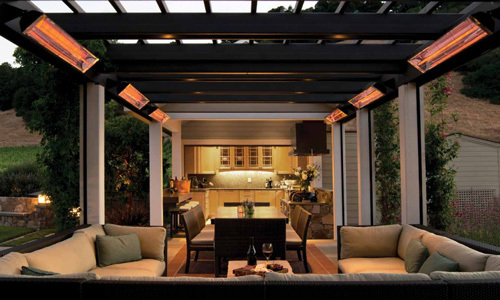
Infrared patio heaters are a great way to extend your outdoor living season and provide warmth during chilly evenings. With so many options available in the market today, it can be overwhelming to choose the right one that meets your needs. Here are some factors to consider when choosing an infrared patio heater:
1. Power Source: Infrared patio heaters come in different power sources including electric, natural gas, and propane. Electric heaters are easy to install and use, but you need a power source nearby. If you don’t have an electrical outlet, you might consider natural gas or propane heaters. However, these heaters require professional installation and a fuel source.
2. Heat Output: The heat output of an infrared patio heater is measured in BTUs (British Thermal Units). The higher the BTUs, the more heat the heater produces. When choosing a heater, consider the size of your outdoor space and the level of heat output you need to keep it warm.
3. Safety Features: Safety is paramount when it comes to patio heaters. Look for heaters that have safety features such as tip-over switches and overheat protection. These features will help prevent accidents and ensure that the heater shuts off in case of any malfunction.
4. Design and Style: Patio heaters come in different designs and styles, so choose one that complements your outdoor décor. If you have a modern style outdoor space, you might consider a sleek and stylish wall-mounted heater. If you have a rustic or traditional décor, freestanding heaters with metal grills might work better.
5. Energy Efficiency: Infrared patio heaters are generally more energy-efficient than traditional heaters. Look for models with energy-saving features such as adjustable heat output settings, a 24-hour timer, and multiple power levels. These features will help you save on electricity bills and reduce your carbon footprint.
6. Brand Reputation: Choose a reputable brand with a good reputation when it comes to patio heaters. These brands will most likely produce high-quality heaters that are durable and long-lasting. Read reviews and ask for recommendations from friends or family to help you make an informed decision.
In conclusion, choosing the right infrared patio heater can make all the difference in your outdoor living experience. Consider these factors when making your purchase to ensure that you get the most out of your investment.
Power Source
When it comes to choosing an infrared patio heater for your outdoor space, one of the most important factors to consider is the power source. There are three main types of power sources for infrared patio heaters: electric, natural gas, and propane.
Electric heaters are the easiest to install and use, requiring only a nearby electrical outlet. They are also the most energy-efficient option, as they do not produce any emissions and can be used indoors as well. However, they do have limited heat output and may not be suitable for larger outdoor spaces.
Natural gas heaters, on the other hand, provide a powerful heat output and are better suited for larger outdoor areas. They are also more cost-effective in the long term, as they can be connected directly to your home’s natural gas supply. However, they do require professional installation and may not be suitable for all outdoor spaces.
Propane heaters are a versatile option that can be easily moved around and used in different outdoor spaces. They are ideal for camping trips, outdoor events, and other situations where access to electricity or natural gas is limited. However, they do require a separate propane tank and may not be as energy-efficient as electric or natural gas heaters.
When choosing a power source for your infrared patio heater, it’s important to consider the specific needs and requirements of your outdoor space. Factors such as the size of your space, the level of heat output you require, and your budget will all play a role in determining the best option for you. By carefully evaluating your options and choosing a high-quality patio heater from a reputable brand, you can enjoy comfortable outdoor living all year round.
Level of Heat Output and Heat Source
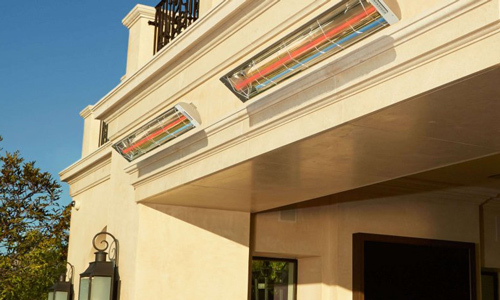
When it comes to outdoor heating solutions, the level of heat output and the type of heat source are two important factors to consider. The level of heat output refers to the amount of heat that a heater is capable of producing, while the heat source is the mechanism by which the heater generates that heat. Understanding these two factors can help you choose the right type of heater for your outdoor space.
The level of heat output is typically measured in BTUs (British Thermal Units), which indicate the amount of heat required to raise the temperature of one pound of water by one degree Fahrenheit. In general, the higher the BTU rating of a heater, the more heat it will produce. However, it’s important to note that the effectiveness of a heater can also be influenced by factors such as wind, humidity, and the design of your outdoor space.
The type of heat source also plays a critical role in determining the level of heat output. There are a variety of heat sources to choose from, including electric, natural gas, propane, and infrared radiation. Each of these heat sources has its own advantages and disadvantages.
Electric heaters are powered by electricity and use an electric heating element to produce heat. They are easy to install and require only a nearby electrical outlet. They are also highly energy-efficient, as they do not generate any emissions. However, they may not be suitable for larger outdoor spaces and may not provide as much heat output as other types of heaters.
Natural gas heaters produce heat by burning natural gas, which is generally a more cost-effective fuel source than propane. They provide a powerful heat output and are better suited for larger outdoor areas. However, they do require professional installation and may not be suitable for all outdoor spaces.
Propane heaters are versatile and can be easily moved around, making them ideal for outdoor events and situations where access to electricity or natural gas is limited. They use propane gas as a fuel source and can provide a decent heat output. However, they may not be as energy-efficient as electric or natural gas heaters, and they require a separate propane tank.
Infrared heaters use infrared radiation to produce heat. They are highly efficient, as they only heat the objects and people within their range and do not waste energy by heating the surrounding air. They can produce instant heat and are available in both electric and gas-powered options. However, they may not provide the same level of heat output as other types of heaters.
Overall, the level of heat output and heat source are two critical factors to consider when choosing an outdoor heating solution. By understanding your options and weighing the advantages and disadvantages of each, you can select a heater that is the best fit for your outdoor space and your heating needs.
Instant Heat Ability and Energy Efficiency
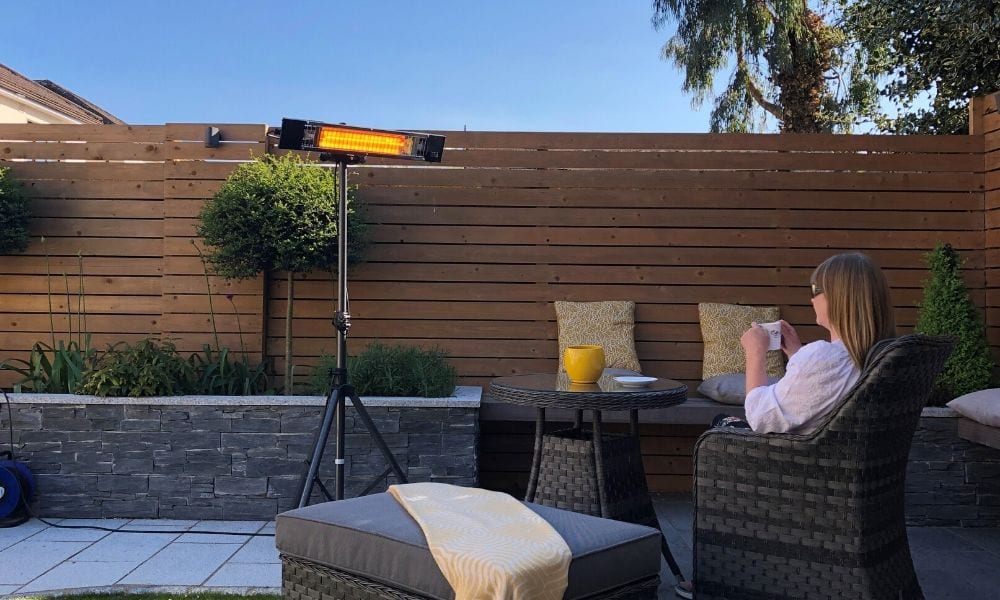
Infrared heaters have become increasingly popular for their instant heat ability and energy efficiency. Unlike traditional heaters that warm up the air around them, infrared heaters use radiant heat to directly warm up objects and people within their range. This means that they can produce instant heat, eliminating the uncomfortable wait time for the surrounding air to warm up.
One of the biggest advantages of infrared heaters is their energy efficiency. They only heat up specific objects and people, rather than the entire room, which means that they waste far less energy than traditional heaters. Infrared heaters are also highly effective at retaining heat, which means that they can continue to warm up a space even after they have been turned off.
Most infrared heaters are available in both electric and gas-powered models, providing flexibility in terms of power sources. Electric models are known for their low energy consumption and reduced carbon footprint, while gas-powered models are often more powerful and better suited for larger outdoor spaces.
In addition to their energy efficiency, infrared heaters also offer a range of safety features. Many models come equipped with automatic shut-off switches that prevent overheating or accidental tipping, as well as remote control options that allow for easy temperature adjustment.
Whether you need a heater for your home patio or for outdoor commercial spaces, infrared heaters offer a versatile and highly effective heating alternative. With their instant heat ability and energy efficiency, they provide a cost-effective solution that can keep you and your guests warm and comfortable during the colder months.
Safety Features
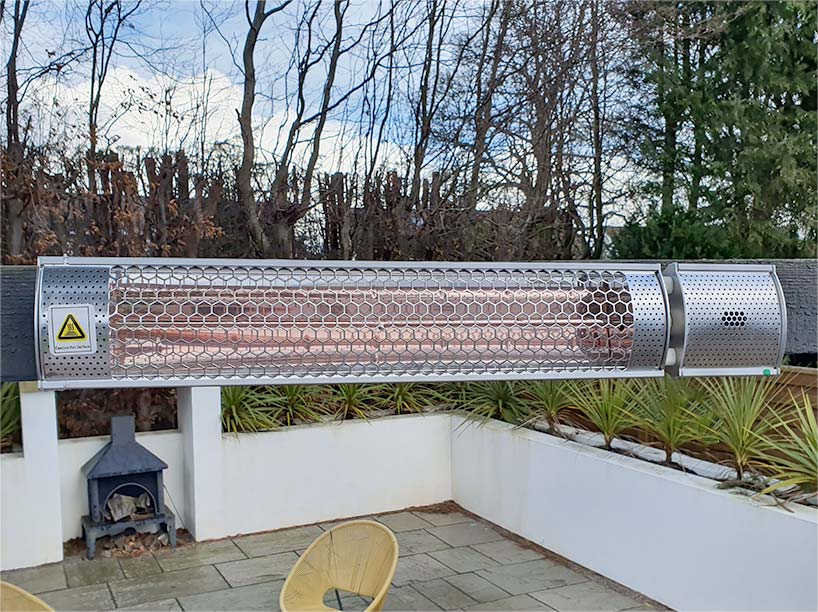
When it comes to choosing an outdoor heater, safety should always be a top priority. Infrared patio heaters have become increasingly popular in recent years due to their ability to provide instant heat and energy efficiency, but they also come with some unique safety features that make them a smart choice for outdoor environments.
One of the most common safety features found in infrared patio heaters is the automatic shut-off switch. This switch is designed to turn off the heater if it detects an unsafe condition, such as overheating or tipping over. This not only protects the heater from damage, but also prevents potential fires or injuries caused by overheating or accidental tipping.
Another key safety feature found in infrared patio heaters is the remote control option. This feature allows users to adjust the temperature or turn the heater on/off from a distance, without having to physically touch the heater. This is particularly useful in situations where the heater is too hot to touch, or if you want to adjust the temperature from a comfortable distance.
Many infrared patio heaters also come with a 24-hour timer, which allows users to schedule when the heater turns on and off. This feature not only saves energy, but also ensures that the heater is only running when it’s needed, reducing the risk of accidental fires or injuries.
In addition to these safety features, it’s important to follow the manufacturer’s safety instructions and use the heater properly. This includes keeping the heater away from flammable materials, not leaving it unattended, and ensuring that the power cord is in good condition.
Overall, infrared patio heaters are a great choice for outdoor heating due to their energy efficiency and instant heat, as well as their range of safety features. Whether you’re looking for a natural gas heater or an electric heater, be sure to choose a model that offers the right level of heat output and safety features for your outdoor environment.
Infrared Radiation Levels in Outdoor Environments

When it comes to outdoor heating, many people turn to infrared heaters for their efficient and effective heating capabilities. But one concern that some may have is the level of infrared radiation emitted by these heaters in outdoor environments.
First, it’s important to understand what infrared radiation is and how it relates to outdoor environments. Infrared radiation is a type of electromagnetic radiation that is invisible to the naked eye but can be detected as heat. It’s the type of radiation that is emitted by infrared heaters to provide warmth.
In outdoor environments, the level of infrared radiation can be affected by various factors, such as the type of heater, the power source, and the size of the area being heated. For example, a gas patio heater may emit a higher level of infrared radiation than an electric patio heater.
But what about the potential effects of infrared radiation on human health? According to the World Health Organization, exposure to high levels of infrared radiation can cause skin and eye damage, as well as increase the risk of skin cancer. However, the level of infrared radiation emitted by properly used and maintained infrared heaters is generally safe for outdoor use.
To ensure safety and minimize potential risks, it’s recommended to follow manufacturer guidelines and use the heater properly. This includes keeping the heater at a safe distance from people and objects, avoiding prolonged exposure, and using safety features, such as automatic shut-off switches and sturdy bases to prevent tipping over.
Ultimately, the level of infrared radiation in outdoor environments will vary depending on the type of heater and other factors. If you have concerns about the level of infrared radiation emitted by your outdoor heater, it’s always best to consult the manufacturer’s specifications and follow safety guidelines to minimize any potential risks.
Advantages and Disadvantages of Using an Infrared Patio Heater

Infrared patio heaters have become a popular choice for outdoor spaces due to their energy efficiency, instant heat, and ease of use. However, like any other type of heater, infrared patio heaters come with both advantages and disadvantages. Let’s take a closer look at these:
Advantages:
1. Energy Efficiency: Infrared patio heaters are more energy-efficient than conventional outdoor heaters. They heat up quickly without wasting energy, so they are a cost-effective way to keep your outdoor space warm and comfortable.
2. Instant Heat: Infrared heaters produce heat within seconds, so they’re a great choice for those who want heat instantly. Unlike other outdoor heaters, you don’t need to wait for the heat to build up.
3. Directional Heat: Infrared heaters can be directed to provide targeted warmth. They have the ability to direct heat to a particular area or person without heating up the entire outdoor space.
4. Safe and Easy to Use: Infrared patio heaters are easy to use and come with safety features to ensure a safe environment. They also have remote controls for easy operation.
Disadvantages:
1. Limited Heat Output: Infrared patio heaters are designed to provide a moderate amount of heat, so they may not be the best option for large outdoor spaces or extremely cold temperatures.
2. Limited Operating Time: Most infrared patio heaters are powered by electricity or propane, which means they have a limited operating time. You may need to refill fuel or recharge the battery to continue using them.
3. Expensive: Infrared patio heaters can be more expensive than other types of outdoor heaters due to their technology and efficiency.
4. Not Suitable for Windy Conditions: Infrared heaters provide directional heat, which can be disrupted by strong winds. They may also blow hot air in one direction, leaving other areas cold.
In conclusion, infrared patio heaters are a great option for outdoor spaces due to their energy efficiency, instant heat, and directional warmth. However, they have some limitations, such as limited heat output, restricted operating time, high cost, and unsuitability for windy conditions. Before purchasing an infrared patio heater, consider your outdoor space, weather conditions, and budget to make an informed decision.
Are Quartz Heaters Energy Efficient?
If you’re looking for an energy-efficient heating solution for your home, you might have come across quartz heaters. These heaters use a combination of radiant and convection heat to warm up a room quickly. However, are they really energy efficient? Let’s take a closer look.
First of all, let’s understand how quartz heaters work. They use a quartz infrared tube to generate heat. When electricity is passed through the tube, it heats up and emits infrared radiation, which in turn heats up objects and people in its path. This means that the heat produced by a quartz heater is directional and focused, and not wasted on heating up the air.
So, are quartz heaters energy efficient? The short answer is yes. Compared to other types of heaters, such as electric fan heaters or oil-filled radiators, quartz heaters are more energy efficient. They heat up quickly, so you don’t need to run them for long periods of time. And because they use infrared radiation, they don’t waste energy on heating up the air around them.
Quartz heaters also have a few other energy-saving features. They typically come with a thermostat, which lets you set the desired temperature and automatically switches off the heater once the room reaches that temperature. This means that the heater doesn’t keep running unnecessarily and consuming energy.
Another energy-saving feature of quartz heaters is the ability to focus heat in a specific direction. This means that you can use the heater to warm up just the area around you, rather than heating up the entire room. This can save a lot of energy, especially if you’re using the heater in a small space.
Of course, the energy efficiency of a quartz heater also depends on how you use it. If you set the temperature too high or leave the heater running unnecessarily, it will consume more energy. However, if you use it wisely and follow the manufacturer’s instructions, you can enjoy the benefits of an energy-efficient heating solution.
Overall, if you’re looking for an energy-efficient heating solution for your home, quartz heaters are definitely worth considering. They heat up quickly, don’t waste energy on heating up the air, and come with energy-saving features such as thermostats and directional heat. Just make sure you use them wisely to maximize their energy efficiency.
Which infrared outdoor heaters are more efficient?
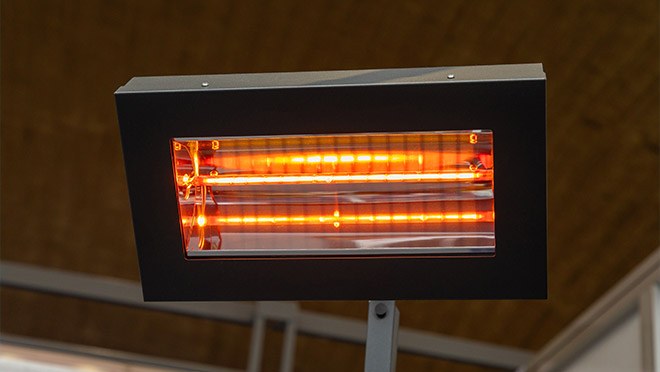
If you’re looking for an efficient and effective outdoor heating solution, you might be considering an infrared outdoor heater. These heaters use infrared radiation to provide instant heat, making them a popular choice for outdoor spaces such as patios, decks, and terraces.
But with so many different types and models of infrared outdoor heaters available, how do you know which one is the most efficient? Here’s what you need to know:
First of all, it’s important to understand the two main types of infrared outdoor heaters: electric and gas. Electric infrared heaters use electricity to power heating elements, which then emit infrared radiation. Gas infrared heaters, on the other hand, use natural gas or propane as a fuel source to heat up a metal grill, which then emits infrared radiation.
In terms of energy efficiency, electric infrared heaters tend to be more efficient than gas models. This is because gas heaters lose some of their energy to combustion, whereas electric heaters convert all of their energy into heat. Electric heaters also tend to be more environmentally friendly, as they don’t produce any emissions or pollutants.
When it comes to choosing an electric infrared heater, look for models that have a high energy efficiency rating. This rating indicates how much of the energy consumed by the heater is actually converted into heat. Look for heaters with ratings of at least 90% or higher.
You should also consider the wattage of the heater. Generally speaking, the higher the wattage, the more heat the heater will produce. However, higher wattage heaters also consume more energy, so it’s important to find a balance between the desired level of heat output and energy consumption.
Other factors to consider when choosing an infrared outdoor heater include the level of heat output, the type of control system (such as a remote control or 24-hour timer), and safety features such as tip-over protection and overheat protection.
Overall, electric infrared heaters tend to be the most efficient option for outdoor heating. By choosing a high-efficiency model and following proper usage guidelines, you can enjoy the benefits of warm and comfortable outdoor spaces without breaking the bank on energy costs.

